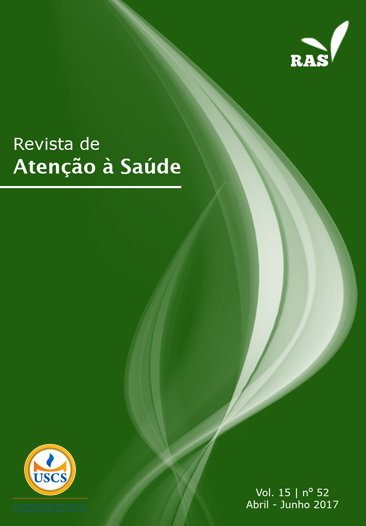Rehabilitation of stroke: literature review
DOI:
https://doi.org/10.13037/ras.vol15n52.4533Keywords:
Stroke, rehabilitation, patient care teamAbstract
Introduction: The prevalence of stroke is high and 90% of survivors develop some type of disability or disability, with impairment of sensory, motor, balance and gait function. Specialized clinical and instrumental evaluations should be used in interdisciplinary practice in order to diagnose the level of commitment, the potentialities, and define the care plan, based on methods for the recovery of deficits or the development of compensations. Objective: To identify in the literature evidences of the effectiveness of the interventions used by interdisciplinary team in the rehabilitation of the patient after stroke, as well as factors that influence the access and delivery of the rehabilitation. Materials and Methods: Integrative review of the literature, from articles published between 2010 and 2015 in the databases: PubMed, Lilacs, Scielo and Cochrane Library. The following were used as descriptors: stroke, rehabilitation and patient care team. Results: 12 studies were included, decisive factors for access and exclusion of the individual in rehabilitation, lack of studies proving the effectiveness of rehabilitation, but rehabilitation improves functional results provided that it is well structured and active in prevention and education of the family. Conclusions: Rehabilitation is a continuous and integral process. It is important the joint participation of the interdisciplinary team, the family and the community in the continuity of care.
Downloads
References
World Health Organization. Cardiovascular diseases
(CVDs) [Internet]. Geneva: WHO; 2013 [citado em 2016
jan 22]. Disponível em: https://goo.gl/A2sC
Jorge MHPM, Laurenti R, Lima-Costa MF, Gotlieb SLD.
A mortalidade de idosos no Brasil: a questão das causas mal
definidas. Epidemiol serv. saúde [Internet]. 2008 [citado em
jan 22];17(4):271-81. Disponível em: https://goo.gl/
XejxKv
Goldstein LB, Bushnell CD, Adams RJ, Appel LJ, Braun
LT, Chaturvedi S, et al. Guidelines for the primary
prevention of stroke: a guideline for healthcare professionals
from the American Heart Association/American Stroke
Association. Stroke [Internet]. 2011. [citado em 2016 jan
;42(2):517-84. Disponível em: https://goo.gl/q6MUUe
Pontes-Neto OM, Silva GS, Feitosa MR, de Figueiredo NL,
Fiorot JA Jr, Rocha TN, et al. Stroke awareness in Brazil:
Alarming results in a community-based study. Stroke
[Internet]. 2008 [citado em 2016 jan 12];39(2):292-6.
Disponível em: https://goo.gl/x99kFd
Kernan WN, Ovbiagele B, Black HR, Bravata DM,
Chimowitz MI, Ezekowitz MD, et al. Guidelines for the
prevention of stroke in patients with stroke or transient
ischemic attack: A guideline for healthcare professionals
from the American Heart Association/American Stroke
Association. Stroke [Internet]. 2011 [citado em 2016 jan
;42(1):227-76. Disponível em: https://goo.gl/0E7IlA
Ryerson S, Byl NN, Brown DA, Wong RA, Hidler JM.
Altered trunk position sense and its relation to balance functions
in people post-stroke. J neuro phys ther [Internet].
[citado em 2016 jan 12];32(1):14-20. Disponível
Cruz KCT, D’Elboux DMJ. Evaluation of functional capaciy
in elders with encephalic vascular accident. Acta paul
enferm [Internet]. 2009 [citado em 2016 feb 4];22(5):666-
Disponível em: https://goo.gl/scJ6hl
Scalzo PL, De Souza ES, Moreira AGO, Vieira DAF.
Qualidade de vida em pacientes com Acidente Vascular
Cerebral: clínica de fisioterapia. Rev. neurociênc. (Impr.)
[Internet]. 2008 [citado em 2016 jan 22];18(2):139-44.
Disponível em: https://goo.gl/IkhJIS
Brasil. Ministério da Saúde. Secretaria de Atenção à Saúde.
Departamento de Ações Programáticas Estratégicas.
Diretrizes de atenção à reabilitação da pessoa com acidente
vascular cerebral. Brasília, DF: Ministério da Saúde; 2013.
Brasil. Ministério da Saúde. Secretária de Atenção à Saúde.
Diretrizes de Atenção à Reabilitação da Pessoa com Acidente
Vascular Cerebral. Brasília, DF: Ministério da Saúde; 2012.
European Stroke Organisation Executive Committee,
European Stroke Organisation Writing Committee. Guidelines
for management of ischaemic stroke and transient ischaemic
attack 2008. Cerebrovasc Dis. 2008; 25(5):457-507.
Queiroz E, Araujo TCCF. Trabalho de equipe em reabilitação:
um estudo sobre a percepção individual e grupal dos
profissionais de saúde. Paidéia (Ribeirão Preto) [Internet].
[citado em 2016 jan 12];19(43):177-87. Disponível
Broome ME. Integrative literature reviews for the development
of concepts. Concept development in nursing: foundations,
techniques and applications. Philadelphia (USA):
WB Saunders Company; 2000. p. 231-50.
Whittemore R, Knafl K. The integrative review: updated
methodology. Arch phys med rehabil [Internet]. 2005 [citado
em 2016 jan 22];52(5):543-56. Disponível em: https://
goo.gl/zyAEEo
Ursi ES, Gavão CM. Prevenção de Lesões de Pele no
Perioperatório: revisão integrativa de literatura. Rev latinoam
enferm [Internet]. 2006 [citado em 2016 jan
;14(1):124-31. Disponível em: https://goo.gl/k5MEvM
Melnyk BM, Fineout-Overholt E. Making the case for
evidence-based practice. In: B. M. Melnyk, & Fineout-
Overholt, Evidence-based practice in nursing & healthcare.
A guide to best practice. Philadelphia: Lippincot Williams
& Wilkins; 2005.
Polit DF, Beck CT, Hungler BF. Fundamentos de pesquisa
e enfermagem, métodos, avaliação e utilização. 5 ed. Porto
Alegre: Armed. 2004.
Momsen AM, Rasmussen JO, Nielsen CV, Iversen MD, Lund
H. Multidisciplinary team care in rehabilitation: an overview
of reviews. J rehabil med [Internet]. 2012 [citado em 2016 jan
;44(11):901-12. Disponível em: https://goo.gl/1Ex9mt
Fens M, Vluggen T, van Haastregt JC, Verbunt JA, Beusmans
GH, van Heugten CM. Multidisciplinary care for stroke patients
living in the community: a systematic review. J rehabil
med [Internet]. 2013 [citado em 2016 jan 04];45(4):321-30.
Disponível em: https://goo.gl/v1RYAs
Joseph C, Rhoda A. Activity limitations and factors influencing
functional outcome of patients with stroke following
rehabilitation at a specialised facility in the Western
Cape. Afr Health Sci [Internet]. 2013 [citado em 2016 jan
;13(3):646-54. Disponível em: https://goo.gl/IiLcUk
Tanovic E, Selimovic S, Tanovic H. Assessment of the effects
of rehabilitation after cerebrovascular accident in patients
with diabetes mellitus and hypertension as risk factors. Med
Arch [Internet]. 2014 [citado em 2016 jan 02];68(2):124-
Disponível em: https://goo.gl/RTprV2
Wolf TJ, Chuh A, Floyd T, McInnis K, Williams E.
Effectiveness of occupation-based interventions to improve
areas of occupation and social participation after stroke:
an evidence-based review. Am J Occup Ther [Internet].
[citado em 2016 Jan 02];69(1):6901180060p1-11.
Disponível em: https://goo.gl/ebOi4t
Lindsay P, Bayley M, Hellings C, Hill M, Woodbury E,
Phillips S. Canadian best practice recommendations for
stroke care. CMAJ [Internet]. 2008 [citado em 2016 jan
;179(12 Suppl):S1-S25. Disponível em: https://goo.gl/
JHq6nw
Hakkennes SJ, K Brock, Hill KD. Selection for inpatient
rehabilitation after acute stroke: a systematic review of the
literature. Arch phys med rehabil [Internet]. 2011 [citado
em 2016 jan 22];92(12):2057-70. Disponível em: https://
goo.gl/40dCLE
Scobbie L, McLean D, Dixon D, Duncan E, Wyke S.
Implementing a framework for goal setting in community
based stroke rehabilitation: a process evaluation. BMC
Health Serv Res [Internet]. 2013 [citado em 2016 jan
;13(1):190. Disponível em: https://goo.gl/GrRYsT
Unrath M, Kalic M, Berger K. Who receives rehabilitation
after stroke?: Data from the quality assurance project
“Stroke Register Northwest Germany”. Dtsch Arztebl Int
[Internet]. 2013 [citado em 2016 jan 22];110(7):101-7.
Disponível em: https://goo.gl/gGUIma
Mohd Nordin NA1, Aziz NA, Abdul Aziz AF, Ajit Singh
DK, Omar Othman NA, Sulong S, Aljunid SM. Exploring
views on long term rehabilitation for people with stroke in a
developing country: findings from focus group discussions.
BMC Health Serv Res [Internet]. 2014 [citado em 2016 jan
;14(1):118. Disponível em: https://goo.gl/fLzZKY
McHugh G, Swain ID. A comparison between reported
therapy staffing levels and the department of health therapy
staffing guidelines for stroke rehabilitation: a national survey.
BMC Health Serv Res. [Internet]. 2014 [citado em 2016 jan
;14(1):216. Disponível em: https://goo.gl/YTX9rK
Horne M, Thomas N, Vail A, Selles R, McCabe C, Tyson S.
Staff ’s views on delivering patient-led therapy during inpatient
stroke rehabilitation: a focus group study with lessons
for trial fidelity. Trials [Internet]. 2015 [citado em 2016 jan
;16(1):137. Disponível em: https://goo.gl/Egj07C
National Stroke Foundation (AUS). Clinical Guidelines for
Stroke Management. Melbourne, Australia; National Stroke
Fundation; 2010.
Knecht S, Hesse S, Oster P. Rehabilitation after stroke.
Dtsch arztebl int [Internet]. 2011 [citado em 2016 feb
;108(36):600-6. Disponível em: https://goo.gl/jak32a
Kannel WB. Blood pressure as a cardiovascular risk factor:
prevention and treatment. JAMA. [Internet]. 1996 [citado
em 2016 jan 22];275(20):1571-6. Disponível em: https://
goo.gl/m8XXjP
Momsen AM, Rasmussen JO, Nielsen CV, Iversen MD,
Lund H. Multidisciplinary team care in rehabilitation: an
overview of reviews. J Rehabil Med [Internet] 2012 [citado
em 2016 jan 22];44(11):901-12. Disponível em: https://
goo.gl/9f1T3g
Gadelha IDS, Brito GE, Nascimento JA do et al. Tempo de
acesso aos serviços de reabilitação de pessoas acometidas por
ave. Rev enferm UFPE [Internet] 2015 [citado em 2016 jan
;9(12):1246-24. Disponível em: https://goo.gl/xznAIB
Downloads
Published
Issue
Section
License
Policy Proposal for Journals offering Free Delayed Access
Authors who publish in this magazine agree to the following terms:
- Authors maintain the copyright and grant the journal the right to the first publication, with the work simultaneously licensed under a Creative Commons Attribution License after publication, allowing the sharing of the work with recognition of the authorship of the work and initial publication in this journal.
- Authors are authorized to assume additional contracts separately, for non-exclusive distribution of the version of the work published in this magazine (eg, publishing in institutional repository or as a book chapter), with the acknowledgment of the authorship and initial publication in this journal.
- Authors are allowed and encouraged to publish and distribute their work online (eg in institutional repositories or on their personal page) at any point before or during the editorial process, as this can generate productive changes, as well as increase impact and citation of the published work (See The Effect of Open Access).









